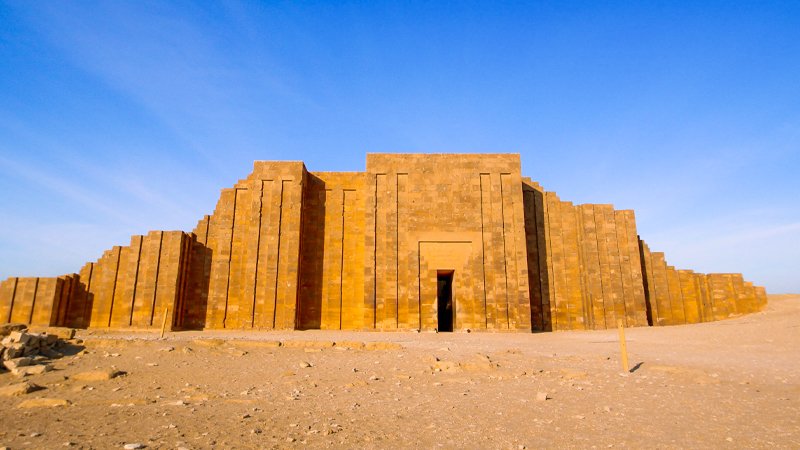Welcome to a captivating journey through time, exploring one of the most iconic structures from ancient Egypt, the Pyramid of Djoser. Nestled in the Saqqara necropolis, this pyramid is a testament to the ingenuity and mastery of ancient Egyptian architects and engineers. This comprehensive article will delve into the fascinating history, construction techniques, and cultural significance of the Pyramid of Djoser, providing a deeper understanding of this remarkable ancient marvel.
Pyramid of Djoser: A Monumental Feat of Architecture
The Pyramid of Djoser, also known as the Step Pyramid, is an ancient Egyptian pyramid located in Saqqara, near the ancient capital of Memphis. It was constructed during the Third Dynasty of the Old Kingdom, around 2630 BCE. Designed by the renowned architect Imhotep, the pyramid was the final resting place for Pharaoh Djoser, the second ruler of the Third Dynasty. Let’s unravel the details of this awe-inspiring structure.
Unveiling the Architectural Brilliance
The Pyramid of Djoser is a groundbreaking example of ancient Egyptian pyramid design. Unlike its later counterparts, which have smooth, sloping sides, Djoser’s pyramid features a step-like structure consisting of six distinct mastabas stacked on each other, forming a six-tiered structure. The pyramid’s base measures approximately 125 meters in length on each side, with a height of around 60 meters. This innovative design laid the foundation for the evolution of pyramid architecture in ancient Egypt.

The Burial Complex: A Tribute to Royalty
The pyramid is just one element of a larger funerary complex built for Pharaoh Djoser. This complex includes a vast courtyard, several smaller tombs, a mortuary temple, and an offering chapel. The impressive entrance to the complex is marked by a ceremonial gateway known as the “South Tomb.” The entire complex served as a place of worship and offerings for the eternal pharaoh.
Construction Techniques: Ancient Ingenuity at Work
- The construction of the Pyramid of Djoser involved an intricate and innovative process. Ancient builders utilized locally sourced limestone blocks skillfully cut and assembled to create the pyramid’s stepped structure. Imhotep’s mastery allowed for the precise alignment of the pyramid’s corners, reflecting the ancient Egyptians’ deep knowledge of astronomy and geometry.
- To ensure the stability of the structure, the builders incorporated Tura limestone as a facing material. This high-quality limestone provided a smooth and polished exterior, giving the pyramid an imposing and grand appearance. The attention to detail and meticulous planning demonstrated in its construction make the Pyramid of Djoser an enduring architectural wonder.
Pyramid of Djoser: A Beacon of Ancient Egyptian Culture
- Beyond its architectural significance, the Pyramid of Djoser holds immense cultural importance for ancient Egyptians. It represents the belief in the afterlife and the Egyptian concept of eternity. According to their ideas, the pyramid served as a vessel to help the pharaoh’s soul ascend to the heavens and unite with the gods.
- Moreover, the pyramid complex also served as a central hub for religious rituals and festivals dedicated to honoring Pharaoh Djoser and ensuring his smooth journey into the afterlife. It provided a place of pilgrimage for generations to come, where they could pay their respects and offer tributes to their revered pharaoh.
Unraveling the Mystery: Pyramid Complex Excavations
- Several archaeological missions have recently undertaken extensive excavations at the Djoser complex. These excavations have provided valuable insights into the lives of ancient Egyptians, the funerary practices, and the advanced engineering techniques employed during the pyramid’s construction.
- Notable discoveries include artifacts, inscriptions, and offerings within the burial chambers and surrounding structures. These findings have shed light on the rituals and ceremonies associated with the pharaoh’s burial and the religious beliefs that guided the ancient Egyptians’ worldview.
Pyramid of Djoser’s Legacy: Influencing Pyramid Architecture
The Pyramid of Djoser’s unique design and engineering excellence laid the groundwork for constructing subsequent pyramids in ancient Egypt. Its architect, Imhotep, became a revered figure in Egyptian history, with his contributions earning him divine status in later periods. Many later pharaohs sought to emulate Djoser’s pyramid, adding their touches and innovations to create awe-inspiring monuments.

FAQs
Is the Pyramid of Djoser the oldest pyramid in Egypt?
No, the Pyramid of Djoser is not the oldest in Egypt. The oldest pyramid is the Pyramid of Djoser’s predecessor, the Pyramid of Meidum, dating back to the Third Dynasty.
How long did it take to construct the Pyramid of Djoser?
The exact time to construct the Pyramid of Djoser remains to be determined. However, it has taken several years, possibly over a decade, due to the scale and complexity of the project.
Who was Imhotep, and why was he significant?
Imhotep was the chief architect and vizier of Pharaoh Djoser, credited with designing the Pyramid of Djoser. He is one of the earliest-known master architects in history and is revered for his contributions to ancient Egyptian architecture and medicine.
Can visitors enter the Pyramid of Djoser?
Visitors cannot enter the Djoser for conservation and safety reasons. However, the surrounding complex is open to tourists, allowing them to admire the majestic pyramid from the outside.
Is the Pyramid of Djoser at risk of damage or deterioration?
Like many ancient structures, the Djoser faces the risk of damage and deterioration due to environmental factors, tourism, and time. Conservation efforts are ongoing to preserve this invaluable heritage.
What other attractions are near the Pyramid of Djoser?
Several other historical attractions near the Djoser, including the Pyramid of Unas, the Serapeum, and the Mastaba of Ti, offering visitors a chance to explore more of Egypt’s fascinating history.
Conclusion
The Pyramid of Djoser is a testament to the brilliance and ingenuity of ancient Egyptian civilization. It’s step-like structure and cultural significance make it a captivating destination for history enthusiasts and tourists worldwide. As we continue to unearth its mysteries through ongoing archaeological endeavors, we must also strive to preserve this ancient marvel for future generations to behold and appreciate.



